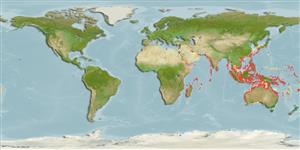Common names from other countries
Environment: milieu / climate zone / depth range / distribution range
Ekologi
Berasosiasi dengan karang; kisaran kedalaman 0 - 45 m (Ref. 800). Tropical
Indo-West Pacific: Red Sea to New Caledonia and Japan.
Length at first maturity / Size / Weight / umur
Maturity: Lm ? range ? - ? cm
Inhabits sandy and rubble areas at depths of 0 to 45 m. Feeds on algae and small invertebrates. Associated with Allopontonia iaini, Periclimenes colemani and Leutzenia asthenosomae (commensals) (Ref. 800). Its movement is assisted by non-venomous spines on the underside of its test (Ref. 85384).
Life cycle and mating behavior
Kematangan | Reproduksi, perkembang biakan | Pemijahan | telur-telur | Fecundity | Larva
Members of the class Echinoidea are gonochoric. Fertilization is external. Brooding is common, eggs are held either on the peristome, around the periproct or deep into the concavities on the petaloids. Life cycle: Embryos develop into planktotrophic larvae (echinoplateus) and live for several months before they sink to the bottom using their tube feet to adhere on the ground where they metamorphose into young urchins.
rujukan utama
Acuan | Koordinator | mitra
Schoppe, S. 2000. (Ref. 800)
Status IUCN Red List (Ref. 130435)
status CITES (Ref. 108899)
Not Evaluated
Not Evaluated
ancaman kepada manusia
Venomous
penggunaan manusia
| FishSource |
Alat, peralatan
informasi lanjut
Umur / Saiz
Pertumbuhan
panjang-berat
panjang-panjang
Morfologi
Larva
Kelimpahan
Sumber internet
Estimates based on models
Preferred temperature
(Ref.
115969): 22.3 - 29, mean 27.8 (based on 1114 cells).
kategori harga
Unknown.
